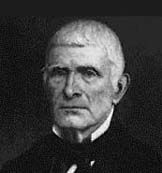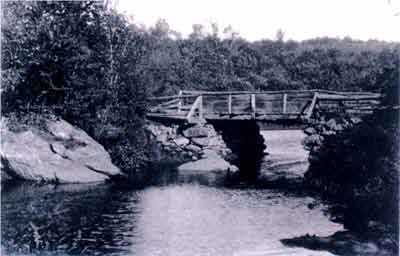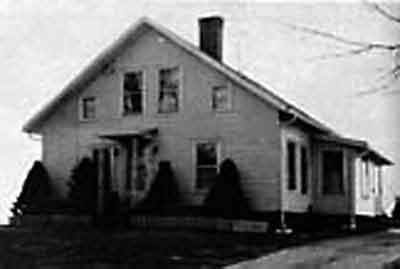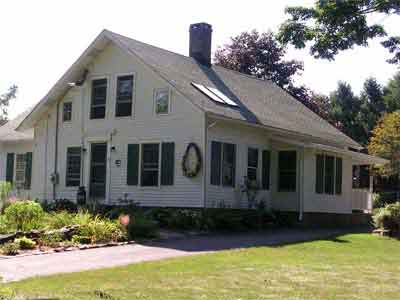|
|
||||||||||||
 |
 |
|
Wolcott Historical Society News - February 2008 By Florence Goodman This month's article will pertain to the second famous American born within our boundary, Seth Thomas. Seth Thomas was renowned as a maker of clocks. James Thomas came from Scotland in the late 1700's and settled in Farmingbury. He built a one and a half story Cape Cod style, post, and beam home (circa 1775) on Spindle Hill near the James Alcott house, which today is just east of the junction of Mad River and Spindle Hill Roads. He married Martha Barnes. (In Samuel Orcott's book, he says that James married Maria Ward of West Haven or Orange, but in his genealogy section, he says that James married Martha Barnes and Orcutt lists all of their children, Seth being one of them.) They had seven children, Seth was the fifth child, and was born in this house in 1785. He lived there until about 1810. James Thomas, was a cooper by trade, a person who repairs casks and barrels, but he also loved carpentry. Seth had a natural ability for carpentry and he probably obtained his knowledge and interest in it from his father. Seth had a limited formal education, and at an early age left school to become a carpenter apprentice to Daniel Tuttle, of Plymouth. Seth was a man who exhibited great energy and perseverance in all that he did; thus, he paid strong attention to the duties of his apprenticeship. On completion of this apprenticeship, he became a skillful woodworker and worked building houses and barns in the nearby towns around Farmingbury/Wolcott (incorporated 1796). In the early 1800's, Seth attempted to set up a clock-making industry in Wolcott. He made his first clock in his family's house. The woods around the house were filled with mountain laurel trees that were used in the production of his clocks. Many Wolcott men worked cutting the trees and sawing them into thin slices, which, when seasoned, were used for the gears of the clocks. The women of the town spun flax into cords and these were used to hold the clock weights. So, the town of Wolcott profited to some extent from Seth Thomas's enterprise, the short time it was located here. In 1807, Seth moved to Plymouth. There he joined Eli Terry and Silas Hoadley in a business of making clocks at a wholesale rate. Seth mainly worked on fitting the wheels and different clock parts together. From 1807 until 1810, they made 4000 clocks of the "hang-up" or "wag-on-the wall" type. These clocks did not have cases, but buyers who wanted cases for their clocks hired carpenters to build what they called "grandfather cases" for them. Around 1810, he made an offer to Mr. Daniel Byington of Wolcott, to purchase mill property on the Mad River. It was believed that the water power of Wolcott was superior to that of Plymouth Hollow and this site would have made an excellent location for his mill. He also asked the town to open a road direct to Cheshire for the export of his manufactured goods, but the town declined his offer. Soon after, Thomas and Hoadley bought out Terry's share of the company and worked together until 1812. At that time, Seth Thomas sold out his share of the company to Hoadley, and went into business on his own in Plymouth Hollow. In time, Seth Thomas built a mill for rolling brass and making wire that he operated in conjunction with his clock factory. It wasn't until 1853 that the Seth Thomas Clock Company was established. Thomas also purchased the manufacturing rights of the shelf clock from Eli Terry and turned this particular type of clock into a big seller. He mass-produced clocks by using automated methods to build and assemble the components of the clocks. Seth's first wife was Philinda Tuttle; they married in the early 1800's and had a daughter, Philinda. After his first wife’s death, he married Laura A. Andrews. They had six children Seth, Martha, Amanda, Edward, Elizabeth, and Aaron. Seth Thomas, Jr. went into the clock business with his father. It was Seth Jr., who enlarged the clock factory and developed it into a world business. Seth Thomas died in 1859 in Plymouth. At that time, that the politicians of Plymouth designated the western portion of the town, where the factory was located, as Thomaston in his honor. (January 25, 2008)
Sources: Badger, Rose Wakelee, Old Wolcott. Orcutt, Rev. Samual, History of the Town of Wolcott From 1731 to 1874, Waterbury, Connecticut, 1874 "Thomas, Seth," Microsoft ® Encarta 98 Encyclopedia. © 1993-1997 Microsoft Corporation
Seth Thomas in his later year.
The Mad River at Center Street. (Several mills were located here.)
The Seth Thomas House at 36 Peterson Lane in Wolcott in 1984.
The Seth Thomas House at 36 Peterson Lane in Wolcott in 2005. To view past installments of the Wolcott Historical Society News, click here. |
|
|
[Home]
[News]
[Purpose]
[Calendar]
[Museum]
[Membership]
[History]
[Contacts]
[Links]
All material at Wolcott Historical Society Web sites Copyright © 2000-2010 Wolcott Historical Society |



